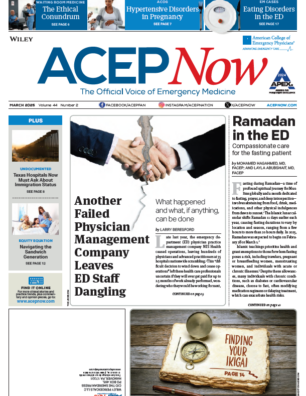
In November, The New England Journal of Medicine (NEJM) published an article of great concern for all emergency physicians as it has the potential to damage and disparage America’s safety net with biased and self-serving data.
Explore This Issue
ACEP Now: Vol 36 – No 01 – January 2017“Out-of-Network Emergency-Physician Bills—An Unwelcome Surprise” attacks emergency
physician balance billing practices.1 Unfortunately, what the authors failed to mention is the data biases of the study, the essential difference of emergency medicine from other specialties, the underlying reasons for balance billing, and the motivation behind the study.
ACEP leaders and our members have pushed back hard on this flawed “study.” A media release was picked up by several news sources across the United States, multiple letters to the editor were sent to various influential publications, and we used the social media megaphone to provide facts that underscore our mission and refute the inflammatory assumptions of the NEJM piece. ACEP also submitted a letter to the editor to NEJM and requested an in-person meeting with the NEJM editorial board. This request, to date, has been declined.
The study published by NEJM relies on a limited amount of data from a single commercial insurer representing fewer than 2 percent of the total US emergency patient visits, hardly representative of the US emergency patient population. It did not account for details such as deductibles and co-pays, making erroneous assumptions about patients’ financial responsibilities. Finally, the data were unavailable for review and include atrocious claims, such as balance bills of more than $19,000, without substantiating evidence or sources. These limitations, apparent biases, were not discussed by the authors or NEJM.
The authors also tried to lump emergency medicine into the result of medical practices. Emergency medicine isn’t a choice. Emergency departments and emergency physicians don’t choose who they treat. We see anyone at any time without consideration of coverage or ability to pay, a federal mandate known as EMTALA. We provide the best care possible to every patient.
Patients are experiencing balance billing because more and more insurance companies refuse to fairly reimburse for the care provided in emergency departments nationwide.
The issue isn’t whether emergency physicians try to contract with insurance companies—it is that insurance companies have no interest in contracting with emergency physicians. It isn’t in their best interest to take on the responsibilities of the uncompensated care we provide. Why would an insurance company be interested in “negotiating a fair price” for a service that is mandated and having a portion of the economic impact successfully shifted to someone else?
As you know, our patients are experiencing balance billing because more and more insurance companies refuse to fairly reimburse for the care provided in emergency departments nationwide. Emergency care is mandated by federal law, and insurance companies know this. This is why there is no interest by the insurance companies to get emergency physicians “in network.”
An increasing number of patients are seeking emergency care for various reasons, and these patients deserve to be supported by the insurance companies they are paying for coverage. There is a surprise emergency care coverage gap in the patients’ insurance policy, a gap that patients often do not know about due to a lack of transparency by their insurer. An unfair burden is being placed on patients as the insurance companies continue to raise rates and decrease or refuse coverage, all while emergency departments are fighting to keep the doors open and beds staffed.
Here are some other stats that the study failed to include about emergency medicine:
- No-pay (uninsured) patients average 15.4 percent of ED visits (323,400 visits out of 2.1 million). Their payments average $23.35 per visit, with 98.1 percent of the charge written off as bad debt or free care.
- Low-pay (Medicaid and managed Medicaid) patients average 31.4 percent of ED visits (659,400 visits out of 2.1 million). Their payments average $58.71, a fraction of the physician’s hourly compensation cost, including malpractice insurance and billing overhead.
- So a total of 46.8 percent of the patient mix (uninsured and Medicaid) are no- to low-pay but are regularly treated under EMTALA without regard to any ability to pay, de facto free care to almost half of all the emergency department’s patients.
Finally, the article’s authors declared financial conflicts of interest, receiving grant money from the National Institute for Health Care Management, an organization led by the nation’s insurance companies representing $190 million in revenue, within the last three years. This group’s mission is to advance the interests of the for-profit insurance industry. Data are important, but publishing studies from a for-profit industry motivated to deflect blame while boosting profits is unfortunate. Such financial conflicts of interest and intellectual bias cannot be reconciled and most certainly biased the outcome of the study, the manuscript, and the authors’ conclusions.
Emergency physicians deliver high-quality care and take care of all patients 24-7-365. We will continue to spread the true story of emergency physicians and their patients. We will aggressively implore NEJM to fully vet health policy articles and to refrain from publishing erroneous and bias data with inflammatory rhetoric under the guise of high-quality, methodologically sound, peer-reviewed literature published in a reputable journal.
 Dr. Stanton is a full-time practicing emergency physician with Central Emergency Physicians in Lexington, Kentucky; host of ACEP Frontline and Everyday Medicine podcasts; and past president of Kentucky ACEP.
Dr. Stanton is a full-time practicing emergency physician with Central Emergency Physicians in Lexington, Kentucky; host of ACEP Frontline and Everyday Medicine podcasts; and past president of Kentucky ACEP.
 Dr. Parker is President of ACEP; an attending emergency physician with West Suburban Medical Center in Oak Park, Illinois; senior vice president of Envision Healthcare; and president of Team Parker LLC, a consulting group. Dr. Parker is also a clinical assistant professor at the Texas Tech El Paso department of emergency medicine.
Dr. Parker is President of ACEP; an attending emergency physician with West Suburban Medical Center in Oak Park, Illinois; senior vice president of Envision Healthcare; and president of Team Parker LLC, a consulting group. Dr. Parker is also a clinical assistant professor at the Texas Tech El Paso department of emergency medicine.
References
- Cooper Z, Scott Morton F. Out-of-network emergency-physician bills—an unwelcome surprise. N Engl J Med. 2016;375(20):1915-1918.
Pages: 1 2 3 | Multi-Page





4 Responses to “ACEP Outlines Flaws, Biases in New England Journal of Medicine Story on Balance Billing”
January 21, 2017
David Meurer, MDWho will speak for EM in a correspondance to the NEJM opinion piece? This would be a good start
February 3, 2017
Rebecca ParkerACEP’s response has been submitted and accepted. We are waiting for the date of publication.
January 23, 2017
Mark L. Madenwald MDEM Physician still see everyone that walks into an ER per federal law. I do so happily. The physicians on the review board for the NEJM certainly do not see every patient that walks into their office. They only see patients that can pay their fees
February 3, 2017
Rebecca ParkerYes, a very important point. The unfunded EMTALA is a crucial component, and unique aspect of emergency medicine. That is a part of my and ACEP’s response to the NEJM.